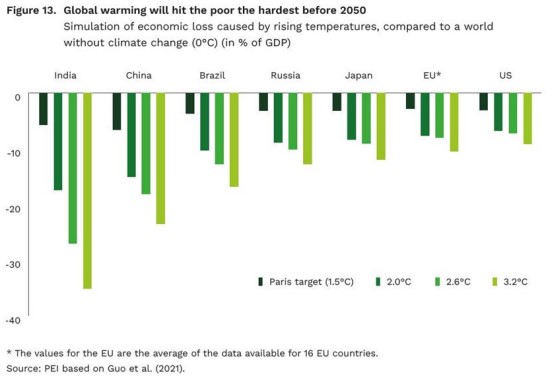The world’s top 7 polluters will need to spend USD 67 trillion by 2030 to reach the Paris Agreement target
Published: 24/05/2022
The Emitting 7 (E7) – the world’s most polluting countries: China, the United States, the European Union, India, Russia, Japan and Brazil – account for almost 72% of global GDP and 66% of global emissions. To stay on course for the 1.5°C target, the E7 will need to spend USD 67 trillion by 2030, the equivalent of 7.6% of global GDP in 2019 and 10.6% of the E7’s GDP in 2019 per year. Failure to reach the target will be even costlier: 11–13.9% of global GDP could be lost per year if the temperature rises by 2–2.6°C. None of these economies will hit its climate goals during its target year. Based on their current trajectories, net-zero emissions will be achieved by the EU in 2056, by the US in 2060, by China in 2071 and by Russia as late as 2086 – according to the Polish Economic Institute’s report entitled The Emitting 7: The time and cost of climate neutrality, presented during the World Economic Forum in Davos.
‘We are living in an era of unprecedented challenges that must be faced simultaneously. The energy crisis caused by Russia’s brutal invasion of Ukraine cannot disrupt our efforts to combat climate change. Instead, it should mobilise us to take further action with greater determination. Moving away from Russian energy commodities is a 4-in-1 opportunity, offering us: energy independence, stronger foundations of long-term economic growth, mitigating climate change and weakening the Russian authoritarian regime. Yet, it must be a collective responsibility. Europe should not bear the cost of combating climate change alone – it is the US, China and India’s responsibility, too. The biggest emitters should spend much more than they planned’, said Piotr Arak, the Director of the Polish Economic Institute.
Mitigating global warming must be coupled with global solidarity
The countries are not doing enough. If they follow their current trajectories, none of the E7 economies will achieve net-zero emissions by 2050 or by their official target years. According to our calculations, the E7 economies’ current commitments will not enable any of them to achieve climate neutrality within their chosen timeframes. The EU will make the transition in 2056 at the earliest, followed by the US and China in 2060 and 2071, respectively. Japan will have a significant delay of 26 years and achieve neutrality in 2076. India will achieve neutrality in 2085 and Russia a year later.
‘Moreover, delaying the green transition would also further increase global inequalities. 10% of the population are responsible for nearly 50% of global emissions. To reach their climate targets, the biggest emitters should increase their efforts and the largest economies need to support developing countries’, said Magdalena Maj, head of the climate and energy team at the Polish Economic Institute.
So far, the EU has pledged USD 625 billion in its programmes. According to our study, the EU needs to increase investments to USD 7 trillion this decade. This translates into 4.5% of its 2019 GDP per year. Japan needs to invest almost 6% of 2019 GDP per year, the US 6.3%, Brazil 7.2%, India more than 19%, China nearly 22% and Russia close to 27%.
‘Climate change tends to have a larger negative impact on developing countries with lower per capita incomes. As a result of their relative wealth, lower growth rates and cooler climate, the EU and the US would face a less severe drop in GDP than Asia. Therefore, a mechanism encouraging a just transition away from a carbon-based economy, towards one based on sustainable development on a global scale, needs to be established. The multiplier effects of green investment on GDP are three times higher than for fossil fuel investments and green land use is as much as twelve times more beneficial for GDP than non-eco-friendly land use. We also calculate that the countries that have done the most to develop a green economy have recorded an average of 10 percentage points more in GDP growth compared to others over the past decade’, said Maciej Miniszewski, a senior analyst on the climate and energy team at the Polish Economic Institute.
***
The Polish Economic Institute is a public economic think tank dating back to 1928. Its research primarily spans macroeconomics, energy and climate, foreign trade, economic foresight, the digital economy and behavioural economics. The Institute provides reports, analyses and recommendations for key areas of the economy and social life in Poland, taking into account the international situation.
Media contact:
Ewa Balicka-Sawiak
Press Spokesperson
T: +48 727 427 918
E: ewa.balicka@pie.net.pl
Kategoria: Analysis / Climate and Energy / Press releases / Report / Reports 2022







